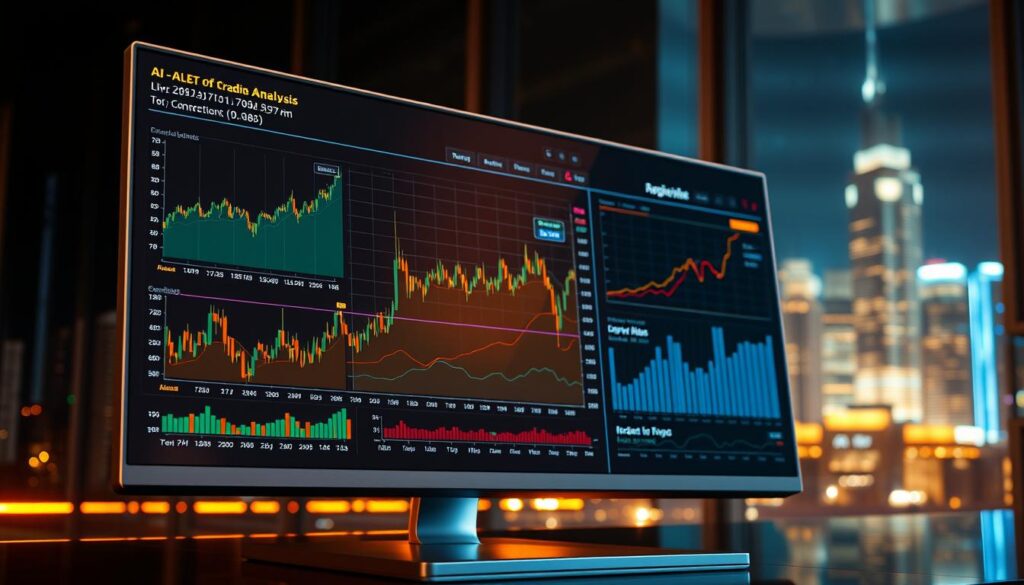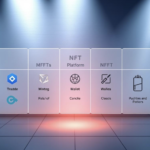Now Reading: Deep Learning Algorithms for Crypto Trading Strategies Explained
- 01
Deep Learning Algorithms for Crypto Trading Strategies Explained
Deep Learning Algorithms for Crypto Trading Strategies Explained

Modern markets demand smarter solutions. Artificial intelligence has reshaped how investors approach digital assets, replacing gut decisions with data-driven systems. This guide explores how cutting-edge technology processes market patterns faster than any human could, opening new opportunities in cryptocurrency markets.
Traditional methods struggle with crypto’s 24/7 volatility. Automated systems now analyze price movements, news sentiment, and blockchain activity simultaneously. These tools identify trends invisible to manual traders, executing trades at optimal moments without emotional interference.
The shift from basic chart analysis to predictive models marks a new era. Institutional players and individual investors alike leverage these systems to compete in fast-paced markets. Our breakdown shows how modern approaches balance risk and reward while adapting to sudden market shifts.
Key Takeaways
- AI-powered systems process market data faster than manual methods
- Automation removes emotional bias from investment decisions
- 24/7 operation matches cryptocurrency market demands
- Advanced pattern recognition improves trade timing accuracy
- Both retail and institutional traders adopt these tools
- Market efficiency increases with widespread algorithmic use
Introduction to Deep Learning Algorithms for Crypto Trading Strategies
Digital asset markets require precision tools that evolve with technological breakthroughs. This section traces how quantitative methods transformed finance – from Ed Thorp’s 1960s computer arbitrage to today’s neural network-driven platforms analyzing Bitcoin fluctuations.
Scope and Goals of This Ultimate Guide
Our analysis bridges six decades of financial innovation. You’ll discover:
- How 1970s stock quote systems paved the way for real-time crypto analysis
- Why Renaissance Technologies’ math models remain relevant for digital assets
- Critical differences between traditional and cryptocurrency trading infrastructures
Background and Industry Relevance in the Crypto Market
When Instinet launched electronic networks in the 1980s, few anticipated their impact on Bitcoin exchanges. Early crypto adopters in the 2010s modified Wall Street strategies for 24/7 markets where prices swing 10% hourly.
Machine learning now processes blockchain data streams and social sentiment simultaneously. This capability helps traders navigate volatility that bankrupted traditional models. Over 78% of institutional crypto transactions now use automated systems.
Deep Learning and Machine Learning in Crypto Trading
Advanced computational methods now drive modern trading platforms. These tools analyze historical patterns and real-time data streams to predict price shifts more effectively than manual approaches. Their ability to process millions of data points gives traders a critical edge in fast-moving markets.

Understanding Neural Networks and Their Role
Neural networks mimic human brain structures to identify complex relationships. They connect price movements, trading volumes, and external factors like regulatory news. For example, these systems might detect how Bitcoin reacts to inflation reports before most traders finish reading headlines.
| Aspect | Machine Learning | Deep Learning |
|---|---|---|
| Data Complexity | Structured datasets | Raw, unstructured data |
| Feature Engineering | Manual input required | Automatic extraction |
| Processing Power | Moderate requirements | High GPU usage |
| Adaptability | Periodic updates | Continuous learning |
Differentiating Approaches in Automated Analysis
Traditional machine learning relies on predefined parameters to evaluate market conditions. It works well with structured data like historical prices. More advanced systems handle chaotic information streams – including social media sentiment and blockchain transaction speeds – without human guidance.
These technologies improve decision accuracy through iterative refinement. A basic model might predict Ethereum trends with 68% accuracy, while neural network-powered systems often exceed 82% in live tests. This gap widens during market turbulence when patterns become less obvious.
Core Concepts of Crypto Trading and Algorithmic Strategies
Volatile digital markets demand frameworks that balance speed and precision. Seven proven methods dominate modern cryptocurrency trading, each leveraging unique mathematical principles to navigate price swings.

Automated systems process real-time data faster than manual analysis. These tools combine technical indicators like moving averages with market sentiment tracking to execute decisions in milliseconds.
Essential Trading Indicators and the Role of Bots
Five key approaches shape successful strategies:
- Moving Average Crossovers: Signals emerge when 50-day and 200-day price averages intersect
- Mean Reversion: Targets undervalued assets likely to rebound to historical averages
- Momentum Plays: Rides established trends using volume and price acceleration metrics
Scalping bots make 100+ daily trades to capture 0.5-2% price gaps. High-frequency systems exploit microsecond advantages, while range-bound strategies thrive during market consolidation.
Day trading requires closing positions before session ends to avoid overnight risks. These methods all rely on three core indicators:
- Relative Strength Index (RSI) for overbought/oversold signals
- Bollinger Bands® measuring price volatility
- On-chain transaction volume trends
Advanced bots adjust strategies when Bitcoin’s 4-hour volatility exceeds 8% or Ethereum faces resistance levels. This adaptability separates profitable systems from static rule sets.
Implementing deep learning algorithms for crypto trading strategies
Building effective trading systems requires merging technical precision with adaptive learning frameworks. Successful implementation starts by creating two parallel environments: a sandbox for strategy testing and a live system for real-market execution. These setups allow bots to learn from simulated scenarios while adapting to actual market conditions.

Step-by-Step Guide to Strategy Implementation
First, configure your training environment using historical cryptocurrency data. This virtual space lets bots analyze price patterns without financial risk. Live trading environments then connect to exchanges through APIs, executing trades based on refined strategies.
Observation spaces combine three critical elements:
- Account metrics like available balance and open positions
- Technical indicators (RSI, moving averages)
- Social sentiment and blockchain activity data
Reward systems start simple – profits trigger positive feedback, losses adjust strategy parameters. Advanced setups incorporate multiple factors like trade frequency and risk exposure. Popular tools include Python libraries for backtesting and cloud platforms for high-frequency trading.
Arbitrage opportunities emerge when price gaps appear across exchanges. Specialized bots scan multiple platforms simultaneously, executing trades within milliseconds. These systems require robust APIs and low-latency connections to capitalize on fleeting advantages.
Data Preparation and AI Model Training for Crypto Trading
Quality data fuels modern trading systems. Effective models require meticulous preparation of diverse information streams – from exchange APIs to blockchain explorers. This foundation determines how accurately systems predict price movements and adapt to new market conditions.

Gathering and Preprocessing Market Data
Traders collect three primary data types:
- Real-time exchange feeds (order books, trade history)
- Social media sentiment scores
- On-chain metrics like wallet activity
Raw numbers undergo normalization to eliminate inconsistencies. Time-series price data gets aligned across exchanges, while text-based inputs use natural language processing. This creates comparable datasets for machine learning analysis.
| Data Type | Preprocessing Step | Usage |
|---|---|---|
| Historical Prices | Gap filling | Pattern recognition |
| Social Posts | Sentiment scoring | Market psychology |
| Blockchain Tx | Address clustering | Whale tracking |
Configuring and Training Neural Networks for Trend Analysis
Network architecture choices impact prediction accuracy. Recurrent neural networks (RNNs) excel at time-series trends, while convolutional networks spot spatial patterns. Most systems use hybrid designs with multiple hidden layers.
Training involves two critical phases:
- Initial learning with historical datasets
- Live adaptation using reinforcement feedback
Models undergo stress testing against black swan events like exchange hacks. This prepares them for sudden market shifts that break conventional analysis methods. Successful configurations achieve 85%+ accuracy in backtests while maintaining low computational overhead.
Backtesting and Simulation of AI Trading Bots
Validating trading systems requires rigorous testing before real-world deployment. Historical data analysis separates promising strategies from flawed approaches, revealing hidden risks in controlled environments. Specialized platforms like QuantConnect enable traders to simulate years of market activity in minutes.
Setting Up Training and Live Trading Environments
Developers use two distinct setups for strategy refinement. Training environments test models against historical price movements and synthetic scenarios. Live systems connect directly to exchanges through APIs, executing real trades under current market conditions.
Key configuration elements include:
- Transaction fee calculations for accurate profit projections
- Slippage modeling to mimic real order execution speeds
- Liquidity thresholds matching target exchange capabilities
Evaluating Performance Using Historical Data
Effective analysis extends beyond basic profit metrics. Traders assess risk-adjusted returns through:
| Metric | Purpose | Ideal Range |
|---|---|---|
| Sharpe Ratio | Reward vs volatility | >1.5 |
| Max Drawdown | Worst-case losses | |
| Win Rate | Trade success frequency | >55% |
Advanced simulation techniques like Monte Carlo testing expose strategy weaknesses. Walk-forward analysis ensures models adapt to shifting market patterns without overfitting to past data.
Risk Management, Ethical Considerations, and Market Adaptation
Navigating cryptocurrency markets requires balancing opportunity with responsibility. Effective systems combine protective measures against sudden price swings with ethical operational standards. This dual focus helps traders maintain profitability while upholding market integrity.
Strategies for Mitigating Risks in Volatile Markets
Stop-loss orders and dynamic position sizing form the backbone of sound risk management. Experts recommend limiting single trades to 1-2% of total capital. Adaptive algorithms monitor volatility thresholds, adjusting exposure during extreme price movements.
Diversification across assets and timeframes reduces reliance on any single market prediction. Real-time liquidity checks prevent slippage during rapid selloffs. These precautions help systems weather 30%+ daily swings common in crypto markets.
Addressing Ethical Concerns in Automated Trading
Spoofing and wash trading remain critical issues in algorithmic systems. Transparent code audits and exchange partnerships help detect fake order patterns. Responsible AI design includes built-in compliance checks for SEC and CFTC regulations.
Developers must prioritize fairness in market access and data usage. Clear disclosure of automated strategies builds trust with users and regulators. Penalties for manipulation now exceed $1 million per violation, making ethics a financial necessity.















